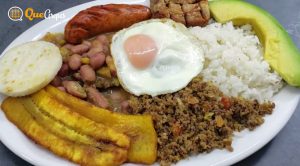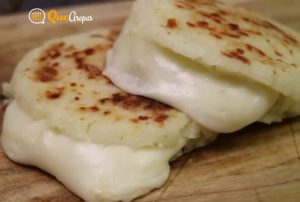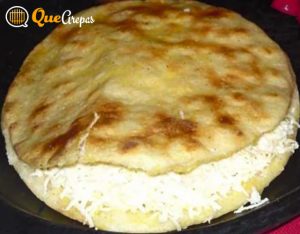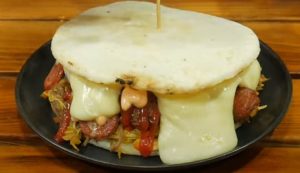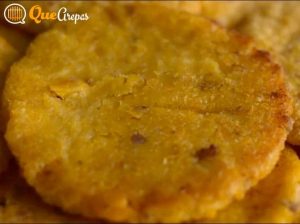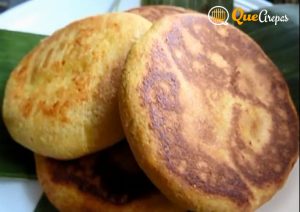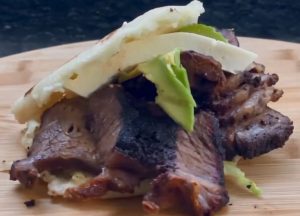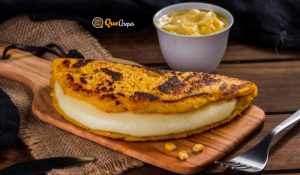Las Arepas Colombianas: A Delicious Culinary Heritage
Discover the irresistible charm of Colombian arepas, a culinary treasure that will delight your senses. With their soft texture and authentic flavors, these maize delicacies have become a symbol of national gastronomy. From the classic cheese arepas to the innovative gourmet fusions, immerse yourself in a world of tradition and creativity. Prepare for an unforgettable culinary journey while we explore the multiple varieties and secrets behind the authentic Colombian arepas. We invite you to discover the true flavor of Colombia in every bite!

The Colombian arepas, that iconic delicacy that evokes tradition and flavor, occupy a prominent place in the rich gastronomy of Colombia. These delicious maize tortillas, filled or plain, have won over the hearts and palates of locals and visitors alike. With their versatility and cultural roots, Colombian arepas are much more than food; representing the culinary identity of a country full of traditions and authentic flavors. Get ready to enter the fascinating world of Colombian arepas and discover why they are a gastronomic treasure that deserves to be celebrated.
History of the Colombian Arepas
Colombian arepas have a fascinating history that goes back centuries. Its origin is intertwined with the indigenous and African influences that shaped the gastronomy of the country.
Origin and evolution of Colombian arepas
Las arepas find their roots in the pre-Columbian indigenous cultures that inhabited the region. The natives used the maize as a base to create a kind of round and flat bread, cooked over hot stones. These first arepas were simple but nutritious, and became a fundamental food for the communities.
With the arrival of the Africans during the colonial era, a cultural exchange was produced that enriched even more the arepas. The Africans brought new culinary techniques and flavors, such as the use of direct fire and the incorporation of ingredients such as queso and meat.
Throughout history, arepas have evolved and adapted to the different regions of Colombia, acquiring unique characteristics and variations in their preparation.
Regional varieties of arepas
Las arepas Colombianas present a diversity of flavors and styles depending on the region:
- Arepas antioqueñas: Originating from the mountainous region of Antioquia, these arepas are characterized by their smaller size and their thickness. They are made with maize harina, which can be mixed with grated cheese, and cooked on a plancha or budare. They are perfect to accompany any food and enjoy themselves especially during breakfast.
- Low-cost arepas: On the Caribbean coast, the arepas are prepared with precooked maize harina and they tend to be thinner and larger compared to other varieties. If doran en una sartén or if they are fired directly. Las arepas costeñas are famous for their abundant fillings, such as shredded meat, chicken, fish, fried chicken and succulent hogao (onion and tomato salsa).
- Arepas llaneras: Coming from the vast plains of the Llanos Orientales, these arepas stand out for their considerable size and their traditional stuffing of shredded meat or stewed meat. They are made with maize harina and cooked on a plancha or grill. Las arepas llaneras are a blunt main plate and represent the essence of the llanera culture.
Arepas in Colombia are not only a daily and essential food in the family home, but have become one of the main dishes of street food and even an alternative food to fast food chain restaurants. For Colombians, the arepa is synonymous with nutrition and is a symbol of belonging to a region and a culture that has its deepest roots in the customs of our native ancestors.
Colombian arepas are the daily bread, and are usually eaten with cheese or butter, with a sweeter taste. Each region of Colombia has its own version of the arepa. In the Cundiboyacense highlands, arepas are prepared mainly with corn, yellow in color and with a soft, dry texture, which is filled with cheese and often with brown sugar or sugar added.
In Antioquia and the Eje Cafetero, it is typical to make very fine arepas with ground corn, cooked and ground, without sweeteners or salt. In the Guajira region, on the other hand, cariaco corn is widely used because of its larger kernel, which is white or purple.
Best Recipes of Colombian Arepas
Colombian arepa recipes are different from their Caribbean and Mexican counterparts. Although they may be similar in the sense that both countries consume flat pieces made from maize, there are some differences. The Colombian recipe for arepas is characterized by spices, flavors and indigenous techniques from Colombia that make them unique in comparison with other types of common breads in Latin America.
Ingredients and Preparation of Colombian Arepas
Las arepas Colombianas are characterized by their simplicity in the ingredients and their versatility in the preparation. Next, we will explore the different types of harina used and the techniques to achieve irresistible homemade arepas.
Types of harina used in arepas:
Colombian arepas are made mainly with two types of maize harina:
- Harina de maíz precocida: This is the most common and convenient option for making arepas at home. This harine has been previously cooked and ground, which facilitates its preparation. It only needs to be mixed with water and salt to obtain a smooth and malleable mass. Harina de maíz precocida can be found in most supermarkets and offers consistent results in the texture and flavor of the arepas.
- Traditional maize harina: Aunque less common nowadays, some people even prefer to use traditional maize harina, which has not been subjected to a precocious process. This harine requires a more laborious preparation, since the maize must be herved and ground before converting it into mass for the arepas. The traditional maize harina can provide a more authentic and rustic flavor to the arepas.
Preparation techniques for Colombian arepas:
Next, the basic steps to make delicious homemade arepas are detailed:
Step by step to make homemade arepas:
- Mix the maize harina with water and salt in a container. Add water gradually until obtaining a smooth and manageable mass.
- Knead the dough for a few minutes until it is smooth and elastic.
- Divide the dough into portions and form flat and round discs.
- Heat a plancha or non-stick pan on medium-high heat.
- Place the arepas on the hot plate and cook them for about 4-5 minutes on each side, until they are golden and crunchy.
- Remove the arepas from the plancha and let them cool slightly before serving.
Secrets to achieve a perfect texture and flavor:
- Add a little butter or oil to the dough to obtain a smoother texture and richer flavor.
- Make sure that the plancha or sartén is hot before adding the arepas. This will help you to cook them correctly and acquire the desired gold.
- To obtain a more spongy texture, you can add a little yeast or baking soda to the dough.
- Experiment with different ingredients and flavors in the dough, such as grated cheese, choclo (tender maize) or fresh hierbas, to add a personalized touch to your arepas.
Traditional Preparation Techniques
Traditional preparation techniques are essential to create authentic and delicious Colombian arepas. These steps, handed down from generation to generation, ensure that each arepa retains its unique flavor and texture, capturing the essence of Colombian cuisine.
Molienda del Maíz: Grinding the corn is the first step in creating the base dough for the arepas. An essential process in this step is nixtamalization, an ancient Mesoamerican technique that involves cooking the maize in an alkaline solution, usually lime or ceniza, before grinding it. This process has multiple benefits, including improving the texture of the dough, releasing nutrients and eliminating anti-nutritive components.
After the corn is nixtamalized, it is rinsed and rubbed to remove the outer shell, known as "cascarilla." The corn is then ground in a traditional or modern mill to obtain a dough known as "corn masa." This dough is the base of the arepas and is malleable to shape the delicacies.
Modeling and Cooking: Once the corn dough is obtained, the next step is to shape the arepas before cooking them. There are different methods and ways of shaping arepas, which vary by region and personal taste. Some people prefer to make small balls and then flatten them into discs, while others can form the arepas directly with their hands.
As for cooking, there are two main methods: baking and pan cooking. Baking is usually done in a wood-fired oven or conventional oven, and the arepas are placed on a hot, flat surface inside the oven. Pan cooking involves heating a skillet or grill and cooking the arepas directly on it.
The choice between baking and pan cooking affects the texture and flavor of the arepas. Baking can result in a crispier outside and tender inside texture, while pan cooking can produce a more browned and caramelized surface. Both methods offer unique flavors and are an integral part of the Colombian culinary tradition.
Varieties of Colombian Arepas
Colombian gastronomy is enriched with a wide range of varieties of arepas that vary in ingredients, preparation processes, and flavors. Next, we'll explore two of the most popular varieties: white corn arepas and yellow corn arepas.
Arepas de Maíz Blanco:
White corn arepas are a classic in Colombian cuisine. These arepas are characterized by their use of white corn, which goes through a special preparation and grinding process. Unlike other types of corn, white corn is softer and has a more delicate flavor.
The preparation process for white corn arepas begins with soaking the corn in water for several hours to soften it. The corn is then ground in a mill or in a specialized machine until a fine mass is obtained. This dough is used to form arepas, which are cooked on a griddle or skillet until golden and crisp.
White corn arepas have a soft and slightly denser texture compared to other varieties of arepas. Its flavor is delicate and complements very well with other ingredients and fillings. They are an excellent option to enjoy with butter, fresh cheese, shredded meat or any other filling of your choice.
Arepas de Maíz Amarillo:
Yellow corn arepas are another popular variety in Colombia. In this version, yellow corn is used instead of white corn. Yellow corn has a more intense and sweet flavor, which adds an extra dimension to the arepas.
The preparation process for yellow corn arepas is similar to that for white corn arepas. Yellow corn is soaked and then ground into a fine dough. This dough is used to form arepas, which are cooked until golden brown and crisp.
Yellow corn arepas stand out for their vibrant color and distinctive sweet flavor. They are ideal to combine with savory fillings such as meat, chicken, avocado, beans or cheese. The combination of yellow corn with these ingredients creates an explosion of flavors in each bite.
Classic Colombian Arepas and their Rellenos
The Colombian arepas are a true culinary treasure that reflects the richness of the country's gastronomy. Among the most emblematic variants are the queso, choclo and chicken arepas, each with its own distinctive flavor and delicious rellenos.
Arepa de Queso: The arepa de queso is an authentic delight that fuses the softness of the maize with the richness of the Colombian quesos. A variety of regional quesos are used in these arepas, such as queso costeño, queso fresco and queso double crema. Each type of queso adds its own texture and flavor, from queso costeño salado to queso doble crema creamy.
To enhance the queso in the arepas, it is common to combine them with other ingredients that enhance their flavor. You can add pieces of chicharrón for a contrast of textures between the crunchy and the soft one. In addition, the queso arepa is a menudo accompanied by suero atollabuey, a traditional dairy drink that perfectly complements its flavor.
Arepa de Choclo: The arepa de choclo, also known as the tender maize arepa, is distinguished by the use of fresh maize instead of maize mass. This type of arepa is especially popular in regions where fresh maize is a fundamental part of the diet. The preparation of these arepas involves grating the tender maize and mixing it with other ingredients to form a single mass.
The rellenos para las arepas de choclo vary according to the region, but some of the most popular ones include shredded meat, chicken stew and hogao (tomato and onion salsa). These rellenos provide intense flavors that contrast with the natural sweetness of the tender maize.
Arepa de Huevo: The Arepa de Huevo is a traditional dish from the Colombian Caribbean coast and has a fascinating origin. It is believed that this arepa was inspired by the Roman "arepo", a round pan filled with egg that was popular in ancient Rome. La arepa de huevo Colombiana is a unique version that combines the maize mass with a fried huevo inside.
Achieving a perfectly fried chicken arepa requires careful technique. The maize mass is flattened and filled with a new crudo before baking. La clave está en freír la arepa a decuada temperature para que el huevo se cocine sin que la masa se queme. The result is an irresistible combination of crunchy textures and contrasting flavors between the huevo and the maize.
Arepas Santandereanas: Originally from the region of Santander, these arepas are characterized by their extended shape and their use of peeled and ground maize. Suelen accompany themselves with strong flavors like culonas ants and ají.
Arepas Boyacenses: From the region of Boyacá, these arepas are heavy and are cooked in bijao sheets. It can be refilled with queso, meat stew or almojábanas.
Ocañeras Arepas: Originally from Ocaña, these arepas are made with yellow maize and are recognized for their large size and round shape. Rellenan con queso, carne o chicharrón.
Maize Arepa: Prepared with maize, butter, salt and water. To prepare it first, mix the maize with butter, salt and water. Let it rest for a few minutes and then make the balls with the dough. They are placed in a sartén with oil and fried until they are golden.
Arepa Rellena: It is prepared with meat, chicken, onion and cheese. To prepare it first, suffer the meat with onion and let it cool. Luego se añaden los huevos y se revuelven bien. If you make a ball with the mixture, it is placed in an arepa. If you add the queso and fry it in a pan with oil.
Arepa con Chicharrón: It is prepared with chicharrón, onion, ají, queso and butter. To prepare it first, fry the chicharrón in a pan with oil and remove it from the fire. Then mix with the onion and the bell pepper. Add the butter and mix well. Put it in an arepa and add the queso. It is fried in a frying pan with oil until the cheese is melted.
Arepa de Chorizo: It is prepared with chorizo, onion, ají, queso and butter. To prepare it first, the chorizo is fried in a pan with oil and removed from the fire. Then mix with the onion and the bell pepper. Add the butter and mix well. Put it in an arepa and add the queso. It is fried in a frying pan with oil until the cheese is cooked.
Pollo arepa: It is prepared with pollo, onion, ají, queso and butter. To prepare it, first fry it.
More Colombian arepas:
- Arepas Antioqueñas
- Arepas Bogotanas
- Arepas Costeñas
- Arepas Tolimenses
- Arepa Valluna
- Arepa Sarapa
- Arepa Orejeperro
- Arepas paisas
Sides and Sauces for Colombian Arepas
Colombian arepas are even more enjoyable when combined with delicious sides and sauces that enhance their flavor. Next, we'll explore three popular options: hogao, Colombian guacamole, and Colombian cheeses.
Hogao:
Hogao is a traditional Colombian sauce that is commonly used as an accompaniment to arepas. It is prepared with tomatoes, onions, garlic and cilantro, among other ingredients. The basic recipe involves finely chopping the tomatoes and onions, and then frying them together with the garlic in oil until tender. Add chopped coriander and season with salt and pepper to taste. The hogao is simmered until the flavors meld and a thick, flavorful sauce is obtained.
The hogao can be customized according to individual tastes. Some popular variations include adding ají (chili) for a kick of heat, or adding carrots and bell peppers for a little extra sweetness and texture. Hogao is commonly served over arepas, providing a fresh and aromatic flavor that perfectly complements the golden dough.
Guacamole colombiano:
Colombian guacamole is a unique variation on this classic sauce. It is prepared using ripe avocados, lemon juice, tomatoes, red onion, cilantro, and salt. The traditional recipe involves mashing the avocados to a smooth consistency, and then adding the other finely chopped ingredients. Everything is mixed carefully to combine the flavors.
Colombian guacamole is characterized by its freshness and vibrant flavor. The amount of lemon and coriander can be adjusted according to personal preference. In addition, there are other avocado-based sauces that are also delicious to accompany arepas, such as sliced avocado, mashed avocado or even a mixture of avocado with diced tomato and onion.
Colombian cheeses to accompany the arepas:
Colombia is famous for its wide variety of cheeses, and many of them are the perfect complement to arepas. Some commonly used varieties of Colombian cheese include queso fresco, queso campesino, queso costeño, and double cream cheese. These cheeses provide unique flavors and a creamy or slightly salty texture that blends wonderfully with arepas.
The flavor combinations between cheese and arepas are endless. You can enjoy a cheese arepa with an additional cheese filling for an even more intense flavor, or combine different cheeses for a more varied flavor experience. Cheese can also be grated or melted over the arepas to create a smooth texture and delicious flavor.
The secrets of Colombian Arepas
We hope you liked this article about Las Arepas Colombianas: A Delicious Culinary Heritage%.


